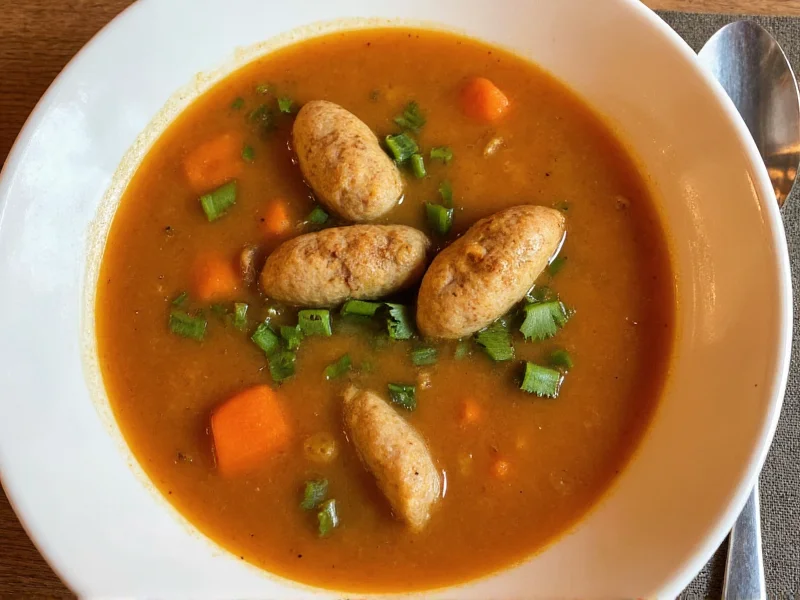Understanding Soup: More Than Just a Definition
When we define soup, we're examining one of humanity's oldest and most universal food preparations. Archaeological evidence suggests humans have been making soup for at least 20,000 years, with early versions likely consisting of water heated in animal skins with added ingredients. The fundamental soup definition centers on a liquid medium that serves as both cooking vehicle and edible component.
Core Characteristics That Define Soup
Several key elements distinguish soup from other food preparations. First, the liquid component must constitute a significant portion of the final dish—typically at least 50% by volume. Second, soup undergoes a cooking process where ingredients simmer together, allowing flavors to blend. Third, soup serves as either a starter course or complete meal depending on its composition and cultural context.
| Characteristic | Essential for Soup | Not Required |
|---|---|---|
| Liquid base (broth, stock, water) | ✓ Must be primary component | |
| Solid ingredients | ✓ Typically included | Clear consommé exceptions |
| Cooking process | ✓ Simmering required | Raw preparations don't qualify |
| Thickening agents | ✓ Optional (roux, purees, etc.) |
Historical Context of Soup
The etymology of "soup" traces back to the Old French word "soupe," meaning broth. Before modern cookware, early humans created primitive soup by heating water with hot stones in containers made of animal skins or hollowed wood. The invention of waterproof pottery around 5000 BCE revolutionized soup preparation, making it a dietary staple across civilizations. In medieval Europe, soup evolved from simple pottages to more sophisticated preparations, with the word "restaurant" originally referring to restorative soups sold by street vendors in 17th century Paris.
Basic Components of Soup
Understanding how to define soup requires examining its fundamental components. The liquid base—whether water, stock, or broth—forms soup's foundation. Stock differs from broth as it's made by simmering bones (providing gelatin and body), while broth uses meat (yielding more flavor). The solid elements typically include vegetables, proteins, and starches that contribute texture and nutrition. Seasonings and aromatics like onions, garlic, and herbs enhance flavor complexity without dominating the dish.
Distinguishing Soup from Similar Preparations
Many people wonder how to define soup versus similar dishes. Stews contain larger ingredient pieces with less liquid, typically requiring longer cooking times. Sauces have significantly less liquid and serve as accompaniments rather than standalone dishes. Broths refer specifically to the liquid component of soup, while consommés are clarified broths. Chilis often blur the line between soup and stew, with regional variations determining their classification—American chili usually qualifies as soup, while European versions often cross into stew territory.
Major Soup Categories
When we define soup types, culinary tradition recognizes several primary categories. Clear soups include broths and consommés where the liquid remains transparent. Thick soups encompass pureed varieties like bisques and cream soups thickened with roux or starches. Specialty soups include chilled preparations like gazpacho and international variations such as Japanese miso or French onion soup. Regional differences significantly influence soup characteristics—Asian soups often feature lighter broths with delicate ingredients, while European traditions emphasize heartier preparations with substantial solid components.
Cultural Significance of Soup
Soup's universal presence across cultures reflects its practical and symbolic importance. Many societies have traditional soups associated with specific occasions—Jewish chicken soup for healing, Vietnamese pho for breakfast, or Brazilian feijoada as a weekend specialty. The phrase "soup kitchen" demonstrates soup's historical role in providing affordable nutrition during difficult times. Modern culinary trends have elevated soup from humble sustenance to gourmet creation, with chefs experimenting with innovative ingredients and presentation techniques while maintaining the fundamental soup definition.
What is the technical definition of soup?
The technical definition of soup specifies a liquid food preparation containing dissolved or suspended solid ingredients, with the liquid component constituting at least 50% of the final volume. Soup must undergo a cooking process where ingredients simmer together to develop flavor, distinguishing it from cold preparations like gazpacho which are technically raw soups.
How does soup differ from stew?
Soup differs from stew primarily in liquid content and ingredient size. Soup contains more liquid (typically 70-90% liquid by volume) with smaller, uniformly cut ingredients that cook relatively quickly. Stew has less liquid (30-50% by volume), larger ingredient pieces, and requires longer cooking times to tenderize tougher cuts of meat. While soup can often be consumed primarily as a liquid, stew requires utensils to eat the substantial solid components.
Is broth the same as soup?
Broth is not the same as soup, though it serves as soup's foundation. Broth refers specifically to the liquid component made by simmering meat, bones, and aromatics. Soup incorporates broth but adds substantial solid ingredients like vegetables, grains, or proteins to create a complete dish. You can think of broth as the starting point for many soups, but broth alone doesn't meet the full definition of soup which requires additional components beyond just the liquid base.
Can soup be cold?
Yes, soup can be cold and still meet the definition of soup. Chilled soups like Spanish gazpacho, French vichyssoise, or Scandinavian fruit soups are legitimate soup varieties. The key distinction isn't temperature but rather the fundamental composition—cold soups still contain a significant liquid component with suspended or dissolved solid ingredients. Many cold soups undergo initial cooking before chilling, though some like gazpacho are prepared raw.
What makes a dish qualify as soup?
A dish qualifies as soup when it meets three essential criteria: it has a liquid base constituting at least 50% of the volume, contains additional edible ingredients suspended or dissolved in that liquid, and undergoes a cooking process where flavors meld together. The liquid must be substantial enough that the dish can be consumed primarily by drinking, distinguishing soup from dishes with merely saucy components. Cultural context also plays a role, as certain preparations like Japanese miso or Chinese congee have soup-like qualities despite regional naming conventions.











 浙公网安备
33010002000092号
浙公网安备
33010002000092号 浙B2-20120091-4
浙B2-20120091-4